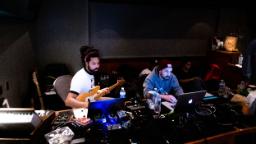
Two years ago, Covid-19 turned the world upside down. While the pandemic isn’t over, The Best in Us is a series that highlights people whose stories of the pandemic illustrate the resilience of the human spirit.
(CNN)Two years after his second project, the critically acclaimed Care For Me, rapper Saba was ready to release his third full-length album.
It was early 2020. The songs were mixed and mastered; the videos shot; the rollout is planned.
You can guess what happened next. Rumors of a ‘novel coronavirus’ became a global pandemic – the world retreated. And this album that Saba released so willingly no longer felt necessary.
“There was nothing wrong with that music,” the 27-year-old told CNN. “But being isolated and spending so much time with myself and my own thoughts and thinking, I was like, ‘Actually, there’s enough of that.’ I don’t want to contribute to the noise. I want to be intentional.”
But there was no blueprint for making art during a global health crisis.
Constant news of record deaths coupled with fear for the health of their loved ones was a unique stressor. Then there was the ongoing racist violence against Black and Asian communities that not only didn’t stop when the pandemic hit, but actually got worse.
Nevertheless, the artists persisted. In April, barely a month into the pandemic, indie folk acts Thao & The Get Down Stay Down shot a music video for their song “Phenom” entirely over Zoom. Electropop artist Charli XCX has been quarantining and workshopping songs at home for her album ‘How I’m Feeling Now’ Live on Instagram with fans. Members of Spillage Village, a hip-hop collective made up of JID, Earthgang, Mereba and others, rented a house together in Atlanta and spent months creating “Spilligion” in their de facto art commune.
Finally, in the pandemic, Saba also made his own album: Few Good Things, which dropped Last month, complete with an accompanying short film.
But the realities of early quarantine made creativity elusive. In the past, sparks of inspiration could hit you just by walking, Saba said. If you’re just sitting at home, it’s more difficult – you have to work on making the spark fly.
“We had to rely less on inspiration and more on actual practice,” he said. “It’s like going to the gym or something. You have to build a habit.”
So, like many people, he went to Zoom. Along with friends and collaborators (fellow musicians Joseph Chilliams, MFnMelo, Frsh Waters, Squeak and Daedae), Saba cultivated a virtual writing group with the challenge of writing a full verse, 16 bars, in 16 minutes. The group soon grew to about 12 people. Sometimes they met several times a week and always held each other accountable. The creativity then flowed from their community.
As Saba began working on the new album, these larger sessions evolved into smaller ones between him and his two longtime producers, Daedae and Daoud. Because of the pandemic, they couldn’t easily rent time in studios like they could on previous projects. For example, while recording “Care For Me” in 2018, Saba and the others gathered in Oakland, California to work on the project and spent weeks at a time in the studio.
That was no longer possible. Instead, they fed each other audio from their respective computers, which were miles apart, and composed songs from scratch.
Of course, there were some logistical issues—the three-hour time difference between them, for example, made scheduling difficult. But the distance also had a noticeable effect on the music.
It’s most notable on the song “Farmonger,” one of the tracks the trio made entirely over Zoom. One person created the melody while another created the rhythm, but when they first played the riffs through the computer, there was a delay on Saba’s side. What he heard was completely different from what Daoud and Daedae heard.
Later, when they sent the instrument master files to Saba for arranging, he was confused. At first he thought it was wrong. Then they realized the problem.
Saba arranged the track the way he originally heard it – upping the tempo and creating a more funk-heavy sound unlike anything they’d done in the past. This is the version on the album.
“Some things that happen in production or in lyrics are sometimes random. Some of them are just based on a mood or a feeling,” Saba said. “So working without that as the center of creation is… what we had to figure out while making these songs on Zoom.”
With no studio time together, no concerts to connect with fans, Covid-19 has forced many artists back to square one, Saba said. They had to look inward: what artist do you want to be? what songs do you like What message would you like to send?
The last two years were of course associated with setbacks. But it has also made many artists uncomfortable. It’s easy to stagnate in your art, to become complacent. By forcing this uneasiness, Covid-19 has cultivated a new sense of exploration — and that’s where the best art comes from, Saba said.
In that sense, the pandemic wasn’t just about finding new ways to be creative. For artists like Saba, it completely changed their relationship with creativity.
Add Comment